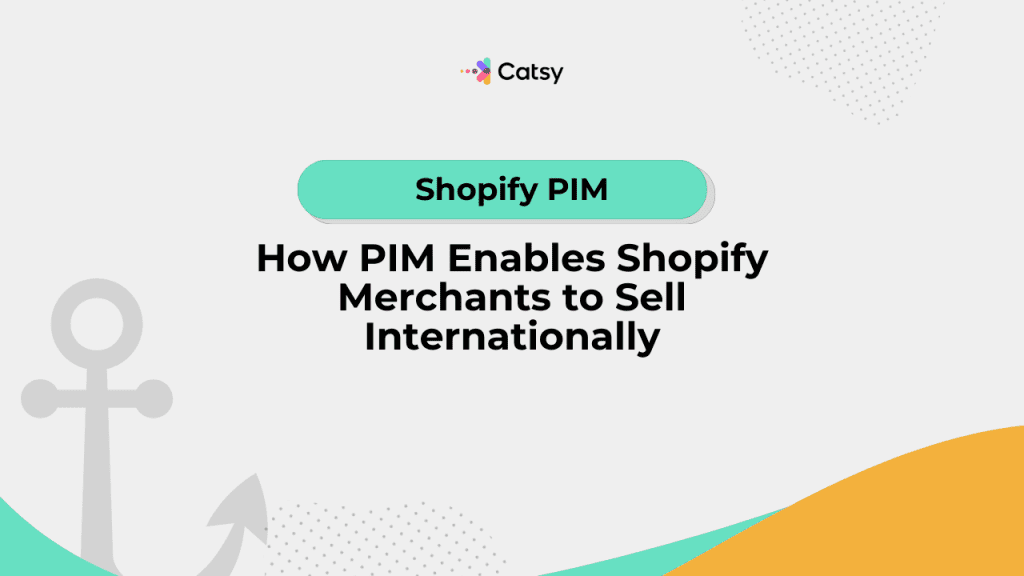How PIM Enables Shopify Merchants to Sell Internationally
Shopify excels at beautiful storefronts, but it falls short in international commerce. Here’s how a PIM can support your Shopify business as you scale globally.

Table of Contents
- Introduction
- The Rising Tide of Global Shopify Commerce
- What Makes International Selling So Complex?
- How PIM Simplifies International Expansion
- International Success: Use Cases of PIM in Action
- Integration with Global Shopify Operations
- Choosing the Right PIM for International Growth
- Conclusion
What You Will Learn
- The top challenges Shopify merchants face when expanding globally
- How PIM supports localization, languages, pricing, and compliance
- Ways PIM enables seamless syndication across international marketplaces
- How Catsy helps Shopify brands streamline international e-commerce
In this Article
1. Introduction
Imagine that you’re the “captain” of a growing Shopify brand. You’re ready to sail beyond your familiar harbors and set sail to new international markets.
Choppy seas lie ahead! Language barrier trouble, currency conversion mixups, and regional regulation headaches are just a sampling of the challenges you’ll face on your voyage.
To navigate these uncharted territories, you’ll need more than a compass. You need a centralized system that will steer your content. That’s where a robust Shopify PIM solution comes in.
In this guide, we’ll explore how Shopify merchants can use PIM solutions to expand globally with confidence and scalability.
2. The Rising Tide of Global Shopify Commerce
The growth of cross-border e-commerce is no longer a distant horizon.
According to Shopify’s Future of E-commerce Report, global e-commerce sales are expected to hit $6.3 trillion in 2024, with cross-border commerce contributing a significant portion.
In reality, Shopify is becoming increasingly supportive of global selling. It offers multi-language support, localized domains, and checkout experiences that are specific to each country.
As you scale, though, your data infrastructure must keep up. That’s where the connection between Shopify and a modern PIM system becomes critical.
Make Catsy DAM and PIM Software an Extension of Your Team
Book a Free Demo3. What Makes International Selling So Complex?
Selling in one market can be tricky enough. Selling across five (of fifty!) markets introduces complexity.
Here are a few of the challenges Shopify merchants face:
- Language Barriers: Translating and maintaining product content in multiple languages.
- Currency Localization: Setting regional prices that account for local currency exchange, taxes, and market rates.
- Regional Regulations: Complying with local packaging, labeling, or legal standards.
- Content Syndication: Delivering region-specific content across multiple channels like Amazon, eBay, or local marketplaces.
- Operational Silos: Managing scattered product data across teams, tools, and markets.
If your data isn’t centralized, these variables can turn your international growth into a squall of inefficiency.
4. How PIM Simplifies International Expansion
Product information management tools simplify the international journey by giving your teams a single source of truth for all of your data… No matter the country, language, or channel you need.
Let’s look at how.
a. Localization of Product Content
Localization includes much more than a general translation of your content. It involves tailoring your descriptions, images, specs, and other attributes to resonate with the local culture.
With a PIM, you can:
- Create region-specific variants of product content … without duplicating data
- Apply local measurement units such as inches or centimeters
- Customize descriptions for regional preferences and buying behavior
According to Contentstack, localized content improves conversion rates by 20 percent or more in global markets.
b. Multi-Language Management
You may find that managing your multi-language content is one of the most tedious aspects you’ll encounter. Manual processes can lead to outdated, inconsistent product listings.
A robust PIM like Catsy automates your multi-language workflows. If houses all language versions of your content in one central place, it integrates with your translation tools and teams, and it ensures that your branding is consistent across each of your target markets.
Shopify Markets integrated with a PIM like Catsy allows you to publish translated content directly to your global storefronts. No duplicate effort required!
c. Currency and Pricing Localization
Each market requires different pricing. That’s not just due to currency, though. You’ll also have to factor in shipping costs, market positioning, and even regional taxes.
PIM tools allow you to:
- Set dynamic pricing rules based on market-specific information
- Integrate with Shopify Markets for localized checkout
- Manage price lists for global retailers or business to business partners
PIM moves your pricing logic from scattered spreadsheets to a scalable database. This will allow you to stay competitive, even internationally.
d. Region-Specific Content & Regulations
In some countries, you must display your product safety warnings, your local certifications, or specific nutritional information. Failure to comply with these requirements can lead to de-listed products … and legal fines.
A PIM enables regulatory alignment by:
- Storing compliance metadata and documentation
- Supporting conditional content rules per market
- Syndicating compliant product information across channels
5. International Success: Use Cases of PIM in Action
Let’s anchor this theory in practice.
A beauty brand sold in Europe, the United States, and Asia. They used Catsy to:
- Maintain multilingual content for over 2,000 SKUs
- Localize ingredients lists according to country
- Syndicate region-specific content to Shopify, Amazon EU, and Shopee
The result? A 40 percent faster time to market for new product launches and a 30 percent decrease in customer-facing errors.
6. Integration with Global Shopify Operations
Catsy’s PIM integrates seamlessly with Shopify to streamline your global workflows:
Shopify Capability | How PIM Enhances It |
Shopify Markets | Auto-sync localized content & pricing |
Shopify Storefronts | Manage multilingual content from one dashboard |
Shopify Plus B2B | Support regional catalogs by customer type |
Third-Party Channels | Syndicate international content to Amazon, Google Shopping, etc. |
Whether you’re selling directly to your consumers on your own website or are listing on retail channels, your PIM keeps your data current. Customer-facing information is always up to date, compliant, and consistent with your brand.
7. Choosing the Right PIM for International Growth
Not all PIMs are equally suited for global e-commerce. As you evaluate systems, look for:
- Localization & translation support
- Integration with Shopify Markets
- Currency & pricing flexibility
- Multi-region content syndication
- User permissions by market or language team
Catsy, for instance, is built to support Shopify merchants who are looking to scale globally. An intuitive UI, automation, and deep syndication make this possible.
8. Conclusion
International commerce is a voyage, and sailing uncharted seas without a PIM is like sailing into a storm. Product information management is your compass and your control center. A PIM simplifies the chaos of localization, compliance, and global syndication.
Are you a Shopify merchant ready to cast a wider net? PIM is the key to expanding internationally.
9. Key Takeaways
- Shopify’s global tools are powerful, but scaling internationally requires centralized content management.
- PIM simplifies global e-commerce by managing localization, language, pricing, and compliance from a single platform.
- Catsy’s PIM integrates seamlessly with Shopify and third-party marketplaces to ensure smooth global product syndication.
- The result: faster launches, fewer errors, and a consistent brand experience across markets.
Want more tips, tutorials, and insights on product content and e-commerce operations?
Stay connected. We post regularly to help brands like yours scale smarter.
Are You Ready To streamline your product content management?
Continue Reading

11. Frequently Asked Questions
Shopify offers features such as localized pricing and language support, but managing your content at scale can be tricky without a PIM, Your product information management system gives you and your teams central control and automation – Shopify does not do this on its own.
Yep! Catsy integrates with Shopify Markets. This allows you to syndicate localized product content, pricing, and attributes across each of your global storefronts.
PIMs like Catsy allow you to “store” every language variant of your content from one centralized place. You can assign teams to specific languages to humanize translations and ensure consistency.
Absolutely! A PIM can store your compliance data, certifications, and your region-specific product data. Then, it will automate syndication based on the specific region’s requirements.
Subscribe For More Content
Sign up for monthly tips on how to drive revenue with product content.




